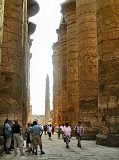
|
The temples
of Karnak and Luxor were in ancient times part of the upper Egyptian city
Thebes, which was over a long time the capital and the cultural center
of the Pharaoh's empire and is known as the city of the hundred gateways.
 It
is a sight of sublime and majestic beauty. An avenue of ram-headed
sphinxes leads the visitor towards the main entrance of the temple.
Monumental Pylons, of a height of more than 40 m, colossal statues such
as those of Ramses II, the gigantic obelisks of the Hapschepsut and
above all the gigantic columns of the famous hypostyle hall – which reach
at the middle road a height of 24m, inspire the visitor with awe and deep
admiration for the overwhelming achievements of a past culture which survived
millenniums. It
is a sight of sublime and majestic beauty. An avenue of ram-headed
sphinxes leads the visitor towards the main entrance of the temple.
Monumental Pylons, of a height of more than 40 m, colossal statues such
as those of Ramses II, the gigantic obelisks of the Hapschepsut and
above all the gigantic columns of the famous hypostyle hall – which reach
at the middle road a height of 24m, inspire the visitor with awe and deep
admiration for the overwhelming achievements of a past culture which survived
millenniums.
 The
temple building was begun in the 12th dynasty (1991-1785 BC) and was continued
over centuries. With an area of about 100 h, Karnak is the largest
and probably also the most impressive temple complex in the world. The
main temple in the heart of the complex is dedicated to God Amun and was
built in the 18th dynasty (1552-1306 BC) The gem of Karnak however
is the famous and well preserved hypostyle hall (columns hall) with its
134 columns - a masterstroke of ancient Egyptian architecture under Setos
I and Ramses II (19. dynasty, 1306-1186 BC). The
temple building was begun in the 12th dynasty (1991-1785 BC) and was continued
over centuries. With an area of about 100 h, Karnak is the largest
and probably also the most impressive temple complex in the world. The
main temple in the heart of the complex is dedicated to God Amun and was
built in the 18th dynasty (1552-1306 BC) The gem of Karnak however
is the famous and well preserved hypostyle hall (columns hall) with its
134 columns - a masterstroke of ancient Egyptian architecture under Setos
I and Ramses II (19. dynasty, 1306-1186 BC).  About
80,000 people employed for the building and decoration of the temple! About
80,000 people employed for the building and decoration of the temple!
Columns and walls of the temple are covered with
paintings and reliefs, which describe in pictures and hieroglyphs the life
and the heroic deeds of the pharohs, as well as the Egyptian mythology.
|